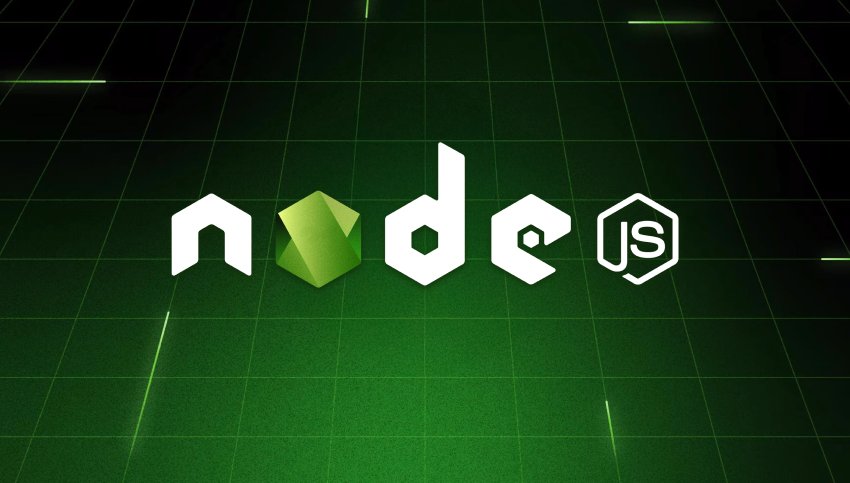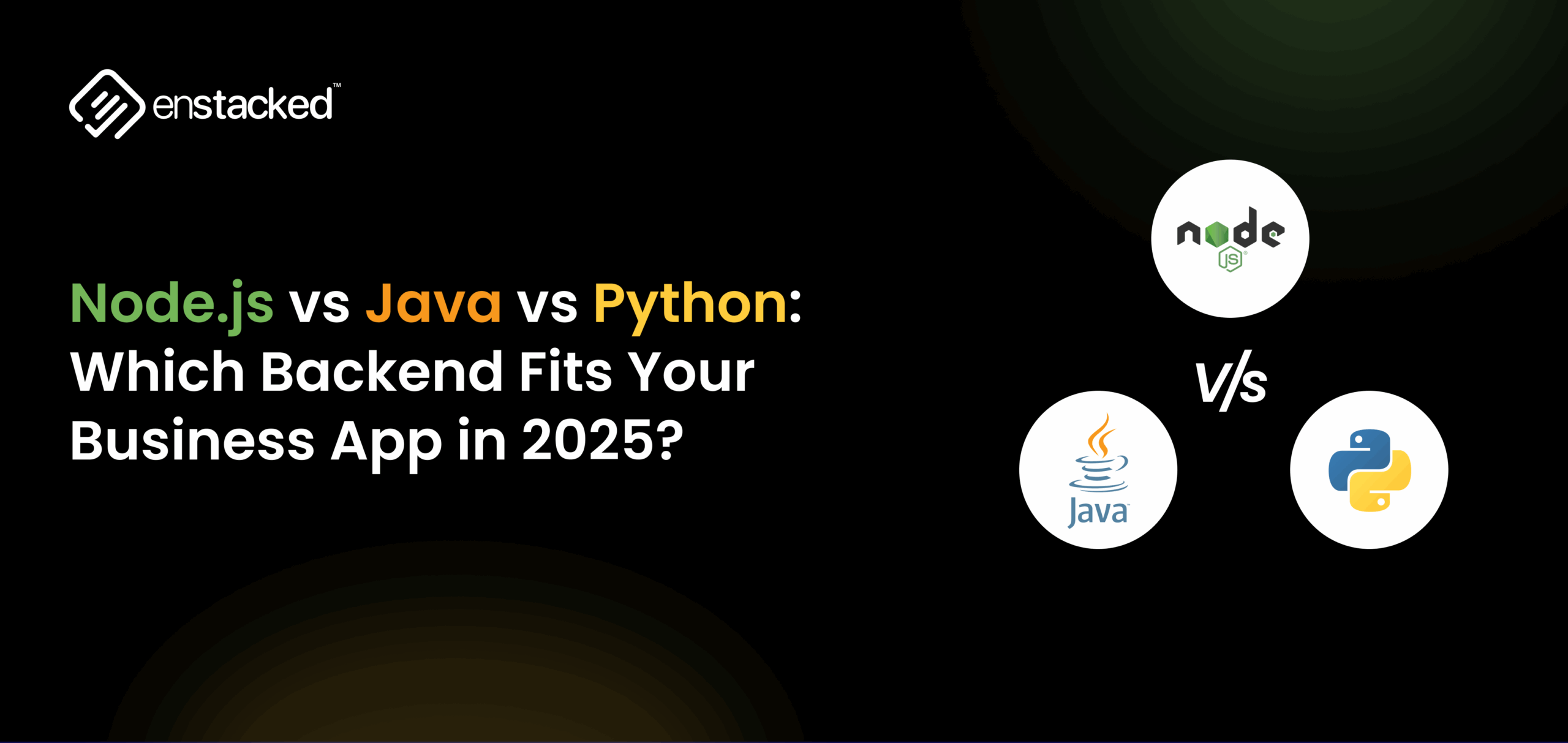Introduction
Choosing the right backend technology can make or break your business application, especially in 2025, where speed, scalability, and adaptability are more critical than ever.
Talking about the top back-end technology provider, three of the most dominant contenders are Python vs Java vs Node.js. Each brings their own strengths, ecosystems, and use cases to the table
As per the Stack Overflow Developer Survey 2024, JavaScript (Node.js) leads backend usage with 55%, followed by Python at 51% and Java at 30% (Stack). Together, they dominate the modern web backend landscape across startups, AI apps, and enterprise systems.
But how do you decide which one between Java vs Python vs Node.js fits your unique business needs?
In this guide, we’ll break down the pros, cons, and real-world applications of each technology, helping you choose the right backend technology that powers your app for growth, performance, and long-term success.
What is Node.js?

Node.js is an open-source, cross-platform JavaScript runtime environment, created by Ryan Dahl in 2009. It allows developers to run JavaScript code outside the browser, typically on the server side, and is widely used to build fast, scalable, and event-driven backend applications.
Node.js powers major companies like Netflix, PayPal, Uber, LinkedIn, and Trello, famous for scaling efficiently under high load.
- Built on Chrome’s V8 Engine: Delivers lightning-fast performance by compiling JavaScript directly to native machine code.
- Single Programming Language: Developers can use JavaScript for both frontend and backend, leading to better productivity and code sharing.
- Non-blocking I/O: Uses an event-driven, asynchronous architecture, ideal for real-time apps, APIs, and microservices.
- Massive Ecosystem: Access to 1.2M+ packages via npm (Node Package Manager)—the largest ecosystem of open-source libraries.
- Scalable Architecture: Handles thousands of concurrent connections, perfect for modern web apps, chat platforms, and streaming services.
- Lightweight & Fast: Powered by Chrome’s V8 engine, Node.js compiles JavaScript to native machine code for speedy execution.
- Cross-platform Support: Runs seamlessly on Windows, macOS, and Linux, making it highly portable for developers.
What is Java?

Java is a class-based, object-oriented, general-purpose programming language. It is widely used for building secure, high-performance, and platform-independent backend applications, especially in enterprise, banking, and large-scale systems.
Java powers mission-critical systems at companies like Amazon, Spotify, Airbnb, Twitter, and banking institutions due to its proven stability and scalability.
- Write Once, Run Anywhere: Java code is compiled into bytecode and runs on the Java Virtual Machine (JVM), ensuring cross-platform compatibility.
- Robust Ecosystem: Offers powerful frameworks like Spring Boot, Hibernate, and Jakarta EE for rapid and reliable backend development.
- Multithreaded and Scalable: Java’s multithreading capabilities allow it to handle high-load, concurrent operations with ease.
- Strong Typing and Strict Syntax: Promotes code reliability, maintainability, and fewer runtime errors—ideal for complex business logic.
- Secure by Design: Java includes built-in memory management, security APIs, and exception handling for end-to-end security.
- Massive Developer Community: Backed by millions of developers worldwide and decades of maturity, Java continues to evolve with cloud-native and microservice support.
- Tooling & IDE Support: Supported by powerful IDEs like IntelliJ IDEA, Eclipse, and NetBeans for advanced development, testing, and debugging.
What is Python?

Python is a high-level, interpreted, general-purpose programming language created by Guido van Rossum and first released in 1991. Known for its readable syntax and developer-friendly design, Python is widely used for backend, especially in data-driven, AI-powered, and rapid-prototyping applications development
Python powers tech giants like Instagram, Dropbox, Reddit, Spotify, and YouTube, favored for its versatility and speed of development.
- Simple & Readable Syntax: Python emphasizes clean code and minimal boilerplate, making it perfect for fast backend development & beginners.
- Batteries-Included Philosophy: Comes with a rich standard library and tools for everything from HTTP handling to data manipulation.
- Popular Frameworks: Backend development is accelerated by powerful frameworks like Django, Flask, and FastAPI, offering scalability, security, and speed.
- AI/ML Integration: Python is the de facto language for artificial intelligence, machine learning, and data analytics.
- Massive Community & Ecosystem: With over 400,000 packages available via PyPI, Python offers libraries for virtually every use case.
- Cross-Platform Support: Runs seamlessly on Windows, macOS, Linux, and is highly compatible with cloud platforms and containers.
Node.js vs Python vs Java – In-depth Backend Technology Comparison!
| Aspect | Node.js | Python | Java |
|---|---|---|---|
| Type | JavaScript runtime built on Chrome’s V8 engine | High-level, interpreted scripting language | Compiled, statically typed, object-oriented programming language |
| Initial Release | 2009 by Ryan Dahl | 1991 by Guido van Rossum | 1995 by James Gosling (Sun Microsystems, now Oracle) |
| Execution Model | Single-threaded, event-driven, non-blocking I/O | Primarily synchronous, but supports asynchronous | Multithreaded model with built-in concurrency and thread management |
| Performance | Very fast in I/O-heavy tasks due to non-blocking architecture and V8 engine | Slower in CPU-intensive tasks, better suited for AI/ML or prototyping | Excellent raw performance for large-scale, computation-heavy apps |
| Use Case Fit | Real-time apps like chat, live updates, APIs, microservices | Rapid development, AI/ML backends, scripting, data apps | Enterprise apps, banking, telecom, legacy systems |
| Concurrency Handling | Handles many simultaneous connections efficiently | Achieved using multiprocessing or asyncio | Native multi-threading with high load handling |
| Syntax & Learning Curve | Simple syntax, easy for JS developers | Very readable, beginner-friendly | Verbose, complex, steeper learning curve |
| Typing System | Dynamically typed; flexible but error-prone | Dynamically typed; readable but can hide errors | Statically typed; compile-time error catching |
| Frameworks & Tools | Express.js, NestJS, Koa, Fastify, Socket.io | Django, Flask, FastAPI, Tornado, Pyramid | Spring Boot, Hibernate, Jakarta EE, Micronaut |
| Package Ecosystem | npm with 1.3M+ packages | PyPI with 400K+ packages | Maven, Gradle, rich enterprise libraries |
| Community Support | Strong among startups, SaaS, JS developers | Huge across AI, data science, education | Enterprise-grade, Oracle-backed |
| Scalability | Excellent horizontal scaling | Moderate, scalable with proper architecture | Exceptional for vertical and horizontal scaling |
| Deployment & Portability | Easy with Node, Vercel, Heroku, Docker | Runs on all OS, cloud & ML integration | JVM-based; deployable on-prem or cloud |
| AI/ML Integration | Limited; better for integrating ML services | Excellent with TensorFlow, PyTorch, scikit-learn | Available via wrappers like DL4J, but less popular |
| Companies Using It | Netflix, PayPal, Uber, Trello, LinkedIn | Instagram, Dropbox, Pinterest, Spotify | Amazon, eBay, Airbnb, Bank of America |
Python vs Java vs Node.js: Final Thoughts!
There’s no one-size-fits-all answer; choosing the right backend between Java vs Python vs Node.js depends on your project’s scale, goals, and tech team.
- Go with Node.js if you need fast, real-time performance with full-stack JavaScript.
- Choose Python for rapid development, AI integration, or data-heavy applications.
- Pick Java when building enterprise-grade systems that demand stability, performance, and scalability.
In the Node.js vs. Java vs Python debate, the winner isn’t universal; it’s the one that best fits your business use case, developer expertise, and future scaling plans.
Still unsure between which one to opt for? Then connect with our professionals at Enstacked. At our IT company, we help businesses make the right decision and hire dedicated developers to take things forward.
To know more, book a free consultation with us today.
Frequently Asked Questions(FAQs)
Which is faster: Node.js vs. Java vs Python?
Java is fastest in raw performance, followed by Node.js for I/O tasks. Python is slower but great for rapid development.
Can I use Node.js, Java, and Python in the same project?
Yes. Many projects combine all three in the same project. Many developers or businesses use Node.js for APIs, Python for ML, and Java for enterprise logic.
What are the main use cases of Node.js, Java, and Python?
- Node.js: Real-time apps, APIs
- Java: Enterprise systems, fintech
- Python: AI/ML, data apps
Which is more scalable: Java vs Python vs Node.js?
Java is most scalable, followed by Node.js. Python is less suited for high-concurrency apps.
